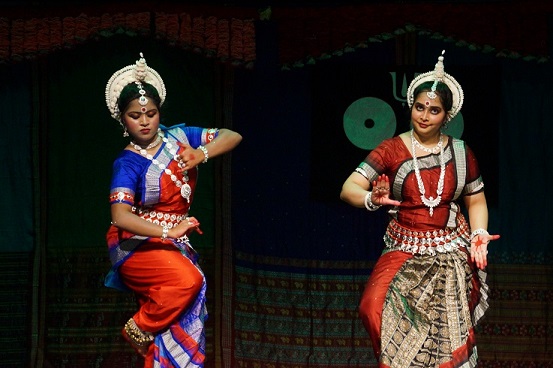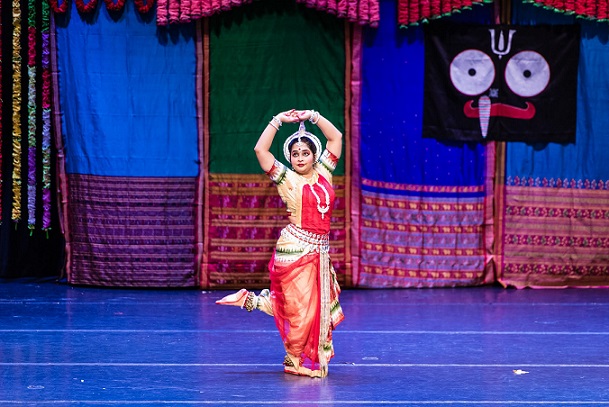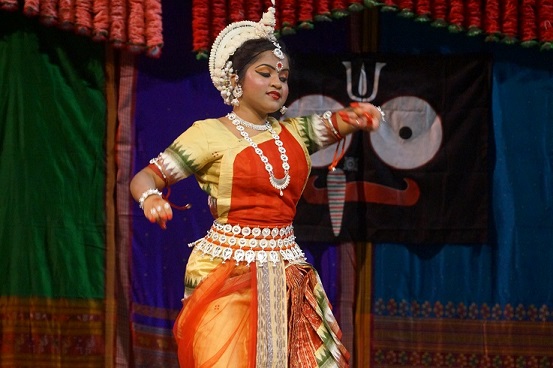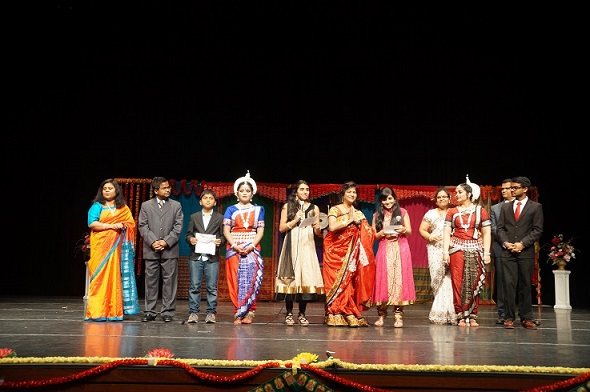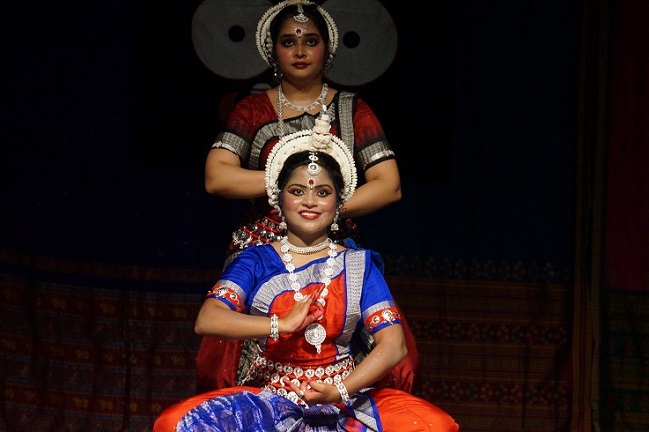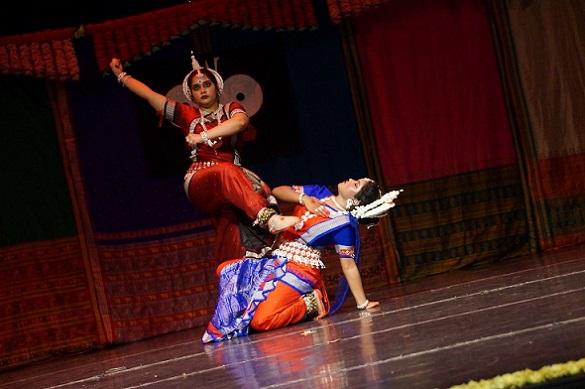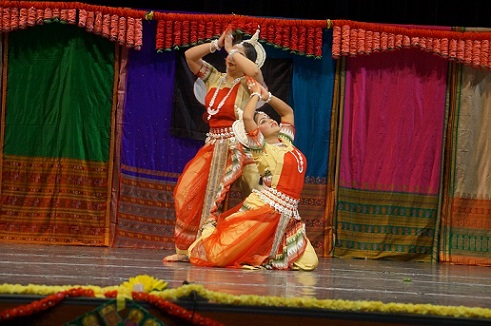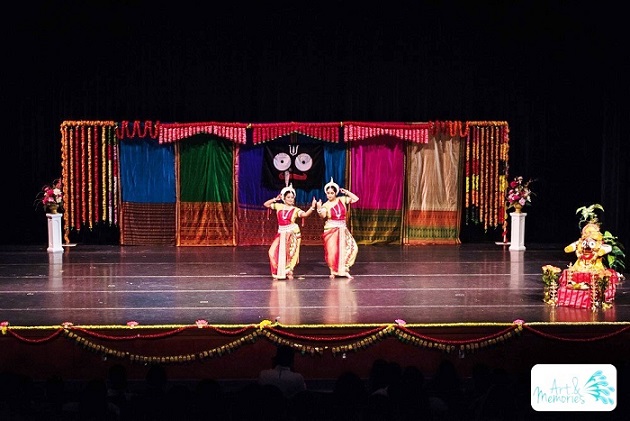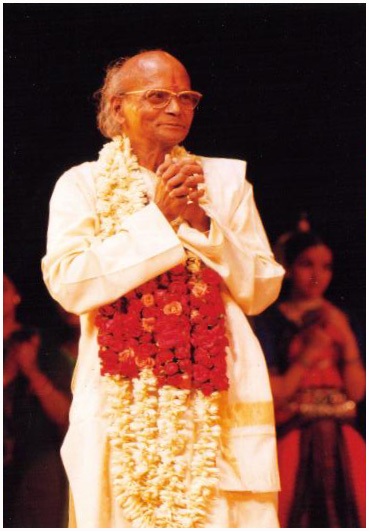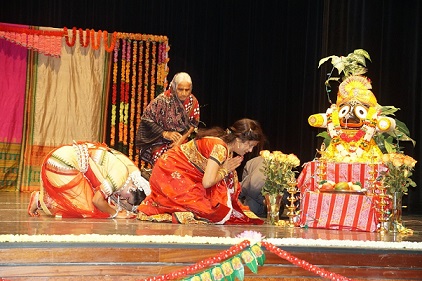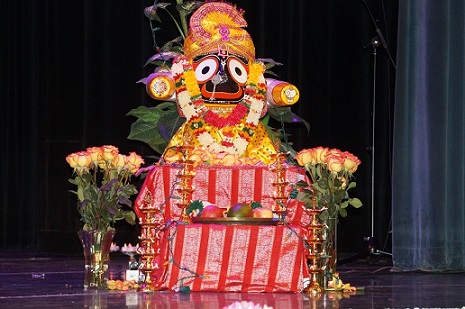Contribute
| Sneha And Arya’s Odishi Mancha Pravesha With Guru Smt. Jayashree Mohapatra |
Bijoy Misra
08/31/2017
Sneha Mahapatra, a graduating senior from Acton High School,
and Arya Mohanty, a High School junior in Winchester had their Odishi Mancha
Pravesha event under the instructions from Guru Smt. Jayashree Mohapatra on
Saturday, August 12, at the Fine Arts Center Auditorium in Regis College,
Weston. It was a spectacular event of
grace, style, footwork and drama.
Cheered by dozens of their classmates and many dance school parents and
neighbors, the pair offered a flawless two hour performance segmented with an
intermission. The stage was beautifully
decorated with several volunteers helping out in light and sound. It was an affectionate outpour of community
love and blessings on two artistic young initiates. The iconic deity of Sri Jagannatha graced the
stage and was reverentially worshipped through the performance. He blessed! After the ceremonial lamp was lit by Arya’s grandmother Smt.
Ratnamani Mohanty, the pair began the program with the traditional Odissi Mangalacharana. Offered to Sri Ganapati and Sri Jagannatha,
the pair offered flowers with sonorous vocal melody following them. The drum beat was soft and the movement was
circular and humbling. After Mangalacharana,
the traditional BatuNritya was performed. Offered to Batuka (the little one) Bhairava,
the dance comprises of statue-like poses as carved in the temple exterior in
Orissa. Arya displayed the drummer, the
string player and the flute player.
Between the poses, the intricate footwork made the dance interesting. After Batu, it was time for the graceful exposition
of nritta. Nritta is an
Odissi segment where the dance interprets a raga into dance. The Nritta part is also called Pallavi,
where the dancer expresses herself through her style and talents with the beats
of the drums and the variation of the melody.
Sneha performed MeghaPallavi, a composition following the raga
Megha (rain). Appropriate to the
season, Sneha started with delicate steps and gradually built up tempo to a
full stage engagement with fast beats.
The recorded music was well done.
Following Sneha’s came Arya’s Pallavi in raga Shankarabharana.The
latter is a Carnataki raga giving Odissi the cosmopolitan color. The intricate Shankarabharana was
melodiously rendered in voice and was gracefully executed with ever increasing
tempo. The full Shankarabharana
is the exposition of nature in its entirety.
Arya undertook the task with grace and poise. Abhinaya is the most expressive part of the Odissi
dance. The classical origin of Odissi is
exhibited through the adoption of the complete set of mudras for the
hands, legs, heels, neck, eyes and waist.
The dancer has the opportunity to merge with the character he or she
plays and tries to create a composite effect of rasa. I was glad that Guru Jayashree had selected
four separate pieces of composition to test the performance style and the
learning expertise of her two students.
Their facial expressions and depiction of the lyric in limb movement
gained acclamation from the audience. The first piece on Abhinaya was an Odia lyric, Manini
radhikaa mana karana based on Jaydeva’s Geetagovinda. It was performed as a duet with Sneha as
Krishna and Arya as Radha. Radha is not
happy with Krishna because of his apparent frivolous promiscuity and Krishna
goes on begging Radha in declaring love.
The piece is always an Odissi hit because of the opportunity of
performing of various emotions in quick succession. The piece ends in a happy note where both
reconcile their differences. The next
piece Durga was done by Sneha alone.
Durga is a Shakti concept that enjoins power from all different
sources in destroying the evil from the earth.
She rides a lion and carries sharp weapons. The demon Mahishasura is eventually
destroyed. The next piece Ardhanarishwara was my favorite. While the concept of the joint appearance of
feminine Prakrti and the masculine Purusha is old, the dancing Ardhanarishwara
is a peculiar Oriya concept. The oriya
cosmology remained liberal through history declaring the nonsymbolism of
eternity. In the anthropomorphic deity
images, the vertical right half is depicted as masculine and the left half is
depicted as feminine. The Shiva
in the right half is strong, powerful and energetic; the Shiva in the
left half is graceful, soft and motherly.
The dancer depicts the right and left in quick succession by letting the
body adjust to the transformation instantaneously. In a long composition of twenty minutes, Arya
moved through the story of Shiva and Parvati, with refrain of NamahShivAyai
and NamahShivAya. She deserved
the full house applause. The next piece was the traditional Dasavatara from
the Geetagovinda of Jayadeva. It is the
physical cosmology of evolution spoken in ten steps. The fish, the tortoise, the boar, the
halfman-halflion, Parsurama, the dwarf, the Rama, the Balarama, the Buddha and
to be manifest kalki – are enacted depicting a stanza each. The dancer has the opportunity to show stage
acrobatics and intricate footwork. Sneha
performed the piece quite well with devotion and grace. The final piece was moksha. Odissi moksha piece can be long and
personal. Guru Jayashree was kind on her
students and wrapped up with a single stanza offered to the eternal
mother. The pair had the occasion to
create formations and to show response to rhythm with symmetry and
harmony. Gorgeously dressed in the rich
traditional Odissi silk with intricate hairdo, the moksha transformed the
auditorium to a temple. The audience
offered a standing ovation. Almost sixty years ago, in 1958, during a massive flood in
Cuttack in Odisha, the revered guru Kelucharan Mahapatra had lost his house and
was staying with us temporarily. This
writer, then a ten year old, was blessed to be his care-taker. Eventually he requested the writer to take
notes of his drum playing. He would
dictate the bols loudly and I would record his voiced sound. He used to teach my sister at home and taught
many other students in local Kala Vikash Kendra. In his time of reflection, he would comment,
“Would any of these girls maintain the tradition through teaching?†He would be in his thirties those days, but
he had dreams. Rarely would he have thought
that one of the later students would teach the tradition in the far away land
of Massachusetts! I was thinking about
those words all evening. Jayashree Mahapatra’s careful attention to details was
noticed in every step. The students
performed to their capacity and enjoyed their work. Their parents and other siblings greeted them
and felicitated them. Guru Jayashree
accepted all admiration with humility, the trademark of the old Kelusir. I personally went back decades in time. The event was compered by two former students Ms. Avani
Bhavsar and Ms. Nimisha Thakkar.
They
announced properly and let the program flow punctually. Sneha’s parents Mr. Asim Mahapatra and Mrs.
Sudhira Misra and Arya’s parents Mr. Arun Mohanty and Mrs. Namrata Mohanty thanked
all and hosted a hospitality supper for the attendees at the end of the
program.
You may also access this article through our web-site http://www.lokvani.com/
